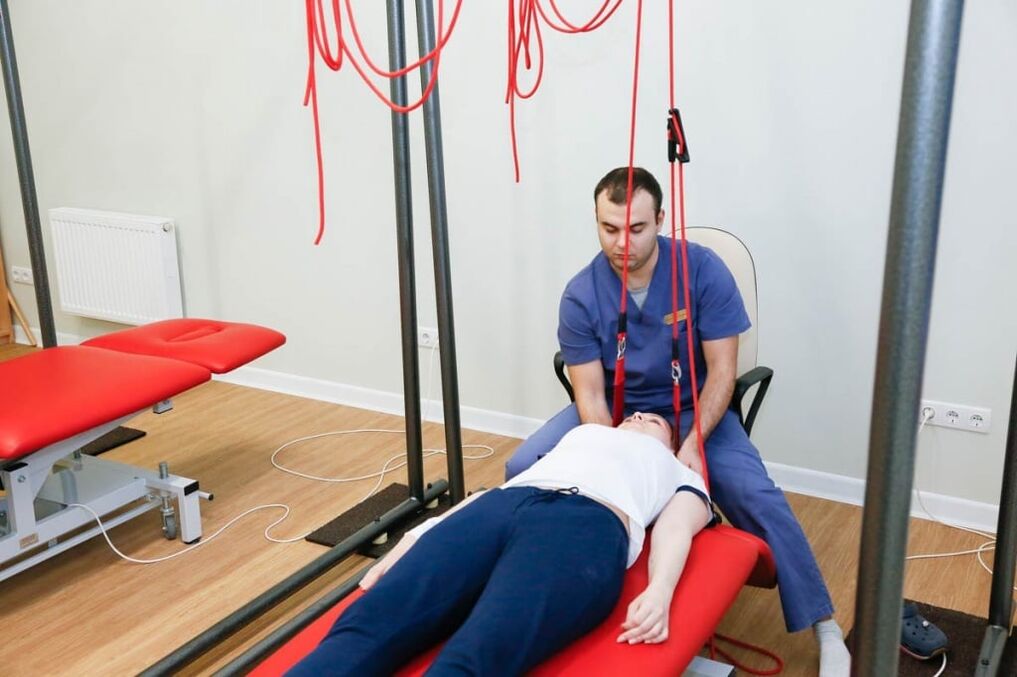Cervical osteochondrosis is a disease that affects the vertebrae and intervertebral discs. Cervical osteochondrosis is a deformed back disease. Degeneration of the intervertebral disc has been observed at the age of 20. At the same time, they are more sensitive to loads, less elastic, and lose lubricating fluid.
In most cases, pathology occurs in the elderly, but the incidence of children and adolescents has increased significantly. Neurologists use the latest diagnostic studies to determine cervical osteochondrosis. After the diagnosis is confirmed, the most effective drugs, physiotherapy procedures and innovative physical rehabilitation methods are used for comprehensive treatment.
The name of the disease is composed of two Greek terms "osteon" (bone) and "chondros" (cartilage). Cervical osteochondrosis begins with changes in the central part of the intervertebral disc. The intervertebral disc loses water and becomes smaller, causing the vertebral bodies to converge and blood vessels to invade the nerve roots. The vertebrae get nutrients from the surrounding tissues, which is harmful to the body. Compression of nerves and blood vessels can cause protective muscle spasms, which can become a cause of pain as the disease progresses.

Which doctor treats this disease
The treatment of osteochondrosis is the field of work of neurologists. However, when symptoms of cervical osteochondrosis appear, you can consult a general practitioner. The neurologist will choose the drug that treats cervical osteochondrosis with the least stress on the body, which is very important for drug treatment.
In order to determine the existence of the cartilage tissue and the pathological process in the osteochondrosis of the cervical and arm, the patient was referred for a comprehensive examination. Strategies for the treatment of cervical osteochondrosis are being formulated based on research results.
Interdisciplinary cooperation can also treat patients’ comorbidities. In addition, patients will receive comprehensive information support: treatment plans, summary of service costs, information on expert consultation and diagnostic measures.
reason
Cervical osteochondrosis develops under the influence of many predisposing factors. The exact cause of cervical osteochondrosis has not been determined. The disease is usually associated with metabolic disorders and vertebral aging.
Researchers believe that the causes of cervical osteochondrosis are as follows:
- Spine pressure is too high. Wearing the wrong shoes, flat feet, obesity, and sitting for a long time can cause high loads on the spine;
- Metabolic disorders. Lack of vitamins, minerals, and calcium metabolism disorders can be the cause of the vertebral degeneration process;
- Congenital and acquired abnormalities of the spine and ligament organs (thickening of ligaments, lumbar vertebralization, sacralization);
- Gastrointestinal disease, leading to insufficient nutrient absorption;
- Infection, poisoning;
- Spinal injuries, bruises, fractures, which cause the blood supply and innervation of the spine to be disturbed, leading to malnutrition;
- pressure;
- Shoes with high heels;
- Pregnancy, especially multiple pregnancy;
- Autoimmune disease of connective tissue, abnormal structure of type 1 and type 2 collagen;
- Occupational hazards (lifting heavy objects, vibrating for a long time, working in a seated position and continuous head tilt);
- Atherosclerosis and other changes of the vertebral artery;
- Spine curvature (kyphosis, scoliosis, kyphosis).
An important risk factor for the development of cervical osteochondrosis is genetic burden. This fact proves that when the spine is not overloaded, children have osteochondrosis.
Bachelor of Science
Due to the special structure of the spine, it can perform its functions. The main structural unit is considered to be the motor segment of the spine (VMS). It consists of two adjacent vertebrae, an intervertebral disc, and a muscle-ligament device. Osteochondrosis leads to malnutrition-a degenerative process, first in the intervertebral discs and then in the vertebrae. With the failure of one vertebra, the performance of its function is provided by the adjacent vertebra. This leads to increased load on the affected part and loss of mobility.
In the development of cervical osteochondrosis, doctors distinguish several stages:
- The first degree of cervical osteochondrosis. Because the intervertebral disc is deprived of its blood supply and receives nutrients from the surrounding tissues, degenerative changes occur. Osteochondrosis in the first stage of development is characterized by the destruction of the nucleus pulposus and fibrous annulus fissures. Clinically, it is manifested as acute or persistent local pain (neck pain) and stiffness in the neck;
- Second degree osteochondrosis of the cervical spine. At this stage, the destruction of the annulus fibrosus continues, and the vertebrae exhibit pathological activity and instability. The patient complains of neck pain, which is aggravated by physical exertion, head tilt, or being in a certain position;
- The third stage of the disease is characterized by the complete destruction of the annulus. The colloidal nucleus is not fixed. A herniated disc may occur and cause severe pain. At this stage, due to poor SMS fixation, a curvature of the spine may be formed;
- In the fourth stage of the disease, the intervertebral disc is replaced by connective tissue, and other adjacent segments are affected. Spondyloarthropathy, arachnoiditis develops. The joints become completely immobile-rigidity develops. Bone tissue grows around the affected area-forming bone. For the fourth degree cervical osteochondrosis, obvious symptoms are observed: severe pain radiates to the area between the arms, sternum, and shoulder blades, and sensitivity disorders.

Symptoms and signs
Early signs of cervical spine osteochondrosis may be non-specific: dizziness, headache, weakness, crunching noises during head movement. As the disease progresses, the following symptoms will appear:
- Severe pain in the neck and shoulders;
- Numbness in the hands;
- Dizziness;
- High blood pressure;
- Impaired motor coordination;
- Increased sweating.
With the development of pathological conditions of the back and cervical spine muscles, several syndromes will appear:
- Neck migraine syndrome.
- Vertebral artery syndrome.
- Hypertension syndrome.
- Heart syndrome.
- Apical syndrome.
They occur when nerve endings are injured and arteries and veins are squeezed as the disease progresses. The most dangerous complication is considered to be vertebral artery syndrome. The blood flow through the arteries that supply blood to the brain and spinal cord is violated. The patient's hearing loss, vision loss, and dizziness continue. The patient may lose consciousness due to severe blood flow disturbances while driving.
Due to the compression of the nerves that are responsible for the innervation of the chest and phrenic muscles, there is pain in the heart area, which is not related to heart disease, but at the same time tachycardia, arrhythmia and hypotension may develop. Compression of veins leads to the development of hypertensive cerebrospinal fluid syndrome. Increased intracranial pressure, nausea, vomiting, and severe headaches are caused by impaired blood flow from the brain.
Because of the squeezing of the neck, nerve root syndrome occurs-severe pain in the neck, shoulders, scapula, and back of the head. With this syndrome, the arm and neck area will be numb. Patients with cervical migraine syndrome worry about severe pain in the back occiput, often accompanied by nausea and vomiting.
Reflex syndrome occurs when the spinal cord has not been affected. The patient complained of pain in the neck, head (especially the back of the head), one or both arms. Unlike radicular pain, reflex pain is not combined with sensitivity disorders. Neck pain may be dull and painful. Sharp "back pain" pain is called cervical spondylosis. There are cramps and muscle pain, and paravertebral points are sore. Signs of cervical osteochondrosis are exacerbated in uncomfortable locations, including head tilt, coughing, and physical exertion. The nerve impulse from the annulus of the affected segment leads to compensatory muscle spasm and signs of epicondylopathy, periscapular arthropathy, and shoulder-hand syndrome.
Nerve root syndrome is accompanied by impaired motor activity and sensitivity. At the same time, due to the reduction of the intervertebral canal, the nerves and blood vessels are damaged, and the venous and lymphatic outflow of the pathological focus is disturbed. The pain of nerve root syndrome is acute and severe. A common cause of spinal nerve compression is hernia formation. In the pathological focal area, muscle tone is reduced. For nerve root ischemia, in addition to nerves, blood vessels are also compressed.
If the phrenic nerve is involved in the pathological process, heart syndrome will occur. It manifests as burning pain and acute pain on the left side of the chest, and it radiates to the arm, the middle area. The name of the syndrome is due to the nature of the pain resembling angina pectoris. The main difference in angina pain is that the pain is relieved after taking nitroglycerin, and it can also occur at rest, accompanied by interrupted heart rhythm (tachycardia, arrhythmia).
The signs of cervical osteochondrosis depend on the location of the pathological process. With the injury of the upper cervical spine, the blood supply to the brain is interrupted by the compression of the cerebral arteries. This can cause headaches (especially in the occipital area), dizziness, fainting, and high blood pressure. Dizziness caused by cervical osteochondrosis is caused by a decrease in blood flow to the inner ear. Patients also worry about nausea, vestibular and ocular symptoms.
With the joint lesions of the vertebrae, they talked about cervical and thoracic spine osteochondrosis. The disease is manifested by the following symptoms:
- Dizziness;
- Pain in the neck and arms;
- Tingling and peristaltic sensation in upper limbs;
- Intercostal neuralgia.
diagnosis
Cervical osteochondrosis is a chronic disease that can cause hernias and spinal cord compression. Therefore, it is important to establish an accurate diagnosis and start treatment in time. In order to identify cervical osteochondrosis, the following types of equipment are used for diagnosis:
- Spine imaging or X-ray examination. This research method is painless, informative, and does not require special training. X-rays of the spine allow you to evaluate its anatomical and functional characteristics. In the picture, pay attention to the structure of the vertebrae, the relationship between them, the distance between them, the lumen of the spinal canal;
- Computed tomography-mainly provides information about the state of bone tissue, allowing you to identify narrowing of the spinal canal and disc herniation;
- Magnetic resonance imaging-allows you to determine changes in soft tissues. The MRI image clearly shows the changes in the intervertebral disc and spinal cord.

medical treatement
The treatment of cervical osteochondrosis includes drug therapy and non-drug therapy. Even after a complete cure, neurologists will take preventive measures to rule out the recurrence of the disease. In the acute phase, in order to treat cervical osteochondrosis, the doctor will prescribe the following pharmacological groups of drugs:
- Non-narcotic analgesics. Oral or intramuscular injection can take effect quickly;
- Non-steroidal anti-inflammatory drugs;
- Large doses of vitamin B.
Diuretics are used to reduce fluid retention in the roots of the spinal cord and surrounding tissues. Antihistamines enhance the effect of analgesics. Muscle cramps are eliminated by muscle relaxants. For long-term severe pain syndromes, neurologists will perform nerve blocks.
In order to improve the metabolic process of the intervertebral disc, chondroprotective agents are used. These drugs increase the content of glycosaminoglycans and increase the firmness, elasticity and shock absorption of the intervertebral disc.
Dizziness pill
Patients with cervical osteochondrosis often experience dizziness. To reduce them, doctors will prescribe non-steroidal anti-inflammatory drugs. The non-steroidal anti-inflammatory drugs belonging to different categories have different mechanisms of action. Therefore, only qualified experts can determine the appropriate drug.
It is important to remember that you cannot take medications for cervical osteochondrosis without a doctor’s appointment. Non-steroidal anti-inflammatory drugs have side effects, so before prescribing a prescription, the neurologist will determine whether the patient has contraindications and the required dosage. Cervical osteochondrosis vertigo drugs can improve the quality of life of patients.
Osteochondrosis injection
Injections to treat cervical osteochondrosis can help relieve pain during the worsening of the condition. With this method of administration, the effect will happen quickly. Neurologists use a variety of injections.
The nurse injects the drug solution subcutaneously, intramuscularly or intravenously. During the deterioration of the disease, drugs administered by injection have the only symptomatic effect on cervical osteochondrosis.
Headache treatment
Headache is a symptom that accompanies various diseases. However, cervical osteochondrosis is characterized by severe headaches. Head movement can aggravate the symptoms, so in order to eliminate it, doctors will prescribe painkillers and non-steroidal anti-inflammatory drugs.

Non-drug treatment
Complex non-drug treatments for cervical osteochondrosis of the spine include:
- Protection mode-when the root is clamped, the patient lies on a hard surface,
- massage;
- Physical therapy exercises;
- Spinal traction
- Physical therapy procedures.
Cervical osteochondrosis massage is used to relieve pain and swelling, improve peripheral blood supply, and eliminate muscle spasms. The contraindication to performing this procedure is the presence of acute pain. Massage the neck and back in the direction of lymph flow. Pay special attention to the interscapular and paravertebral areas.
The therapeutic gymnastics for cervical osteochondrosis aims to eliminate muscle spasms and strengthen the muscle frame. Since vertebral instability often occurs in the cervical spine, the exercise therapy instructor conducts individual lessons during which he teaches patients to exercise safely. Some authors recommend physical therapy sessions in Shants collars.
In order to improve the mobility of the cervical spine, the rehabilitation therapist recommends the following exercises:
- Flexion and extension of the neck. Tilt your head forward toward your breastbone, don't pull your shoulders forward, and then pull back. Keep the upward slope for 3 seconds, and repeat each movement 8-10 times;
- The turning of the neck. First turn your neck to the left until it stops, then turn to the right without changing the position of your shoulders and the level of your chin;
- Lower your head until it stops. Then tilt your head back without changing the level of your shoulders. Hold this position for 5 seconds.
The following exercises have been developed to strengthen the neck muscles:
- Put your hands behind your head. Tilt your head back and place it on your hand;
- Place your hands on the temporal area. Tilt your head and resist with your hands;
- Put your hand on your forehead, resist it, tilt your head forward;
- Tilt your head to the side with your right hand and place your left hand behind your back. Repeat the exercise on the other hand.
Self-weight therapy is the exact name for spinal traction surgery. It is carried out using special equipment. The goal of treatment is to reduce muscle spasms and restore the correct position of the vertebrae. To avoid complications, spine traction is performed by a doctor.
In order to improve the blood supply to the lesion, relieve edema and relieve pain, use the following physical therapy procedures:
- Non-power current. In this process, a special device is used to apply low-frequency current to stimulate the muscles and relieve cramps and pain. Have a positive effect and improve tissue nutrition;
- UV exposure. Under the influence of ultraviolet radiation, the metabolism of vitamin D increases, the calcium content increases, and the bone tissue becomes stronger;
- Contact ultrasound-used to accelerate blood flow, antispasmodic and repair effects. Ultrasound can penetrate deep into tissues and is sometimes used to better absorb drugs;
- Amplipulse therapy-allows you to relieve pain by blocking nerve impulses from the focal point of the pain.
In the acute phase of the disease that lasts 4-7 days, use analgesics, antispasmodics, and stimulants to relieve pain. The patient was calmed down. Use Shants collars to secure the cervical spine. Exercise therapy and massage are contraindicated. Apply ultraviolet radiation.
The duration of the subacute phase is 29 days. After a full recovery, the patient must rest for a few days. Then you can start a course of rehabilitation. In the chronic process of the disease, patients are prescribed muscle relaxants, chondroprotectants, B vitamins, analgesics, and NSAIDs. Provide physiotherapy exercises and massage. The patient is released from the physical therapy procedure (amplipulse, exposure to alternating current) to complete spinal traction.

food
Proper nutrition of osteochondrosis is an important condition for remission. The progress of cervical thoracic spine osteochondrosis will stop with diet and treatment. Neurologists know how to treat cervical osteochondrosis, so they have formulated a series of treatment measures, including surgery, exercise therapy, proper nutrition and lifestyle changes.
Many patients turn to neurologists to ask how to treat cervical osteochondrosis and whether there are any dietary restrictions. Experts will develop a personal nutrition plan based on the patient's preferences. The diet for osteochondrosis is based on balanced, low-fat foods that are rich in nutrients. The patient's daily diet includes high-calcium foods.
How do patients with cervical osteochondrosis fall asleep
For patients with musculoskeletal diseases, how to sleep properly for patients with cervical osteochondrosis is an important issue. Sleeping on your stomach can lead to further development of the disease, so it is best to avoid sleeping in this position. The best positions are on the back and sides.
When lying on a bed with a soft mattress, cervical osteochondrosis will progress. Therefore, experts recommend choosing elastic mattresses and moderately soft pillows first. If the patient is diagnosed with cervical and thoracic osteochondrosis, experienced experts will tell you which bedding is suitable for sleeping.
prevention
In order to prevent the occurrence or progression of cervical osteochondrosis, doctors recommend:
- Maintain the correct posture;
- Lead an active lifestyle and take a break at work;
- Regular physical therapy exercises;
- Sleep on firm and level surfaces, orthopedic mattresses and pillows;
- Get rid of bad habits, especially smoking;
- Choose shoes to consider the physiological structure of the foot;
- Do not carry the bag with one hand, this will cause the spine to bend;
- Lead a healthy lifestyle, eat right, and eat more fruits and vegetables;
- Sit for a long time without tilting your head;
- go swimming.
In order to improve blood circulation, massage therapy should be performed regularly.






























